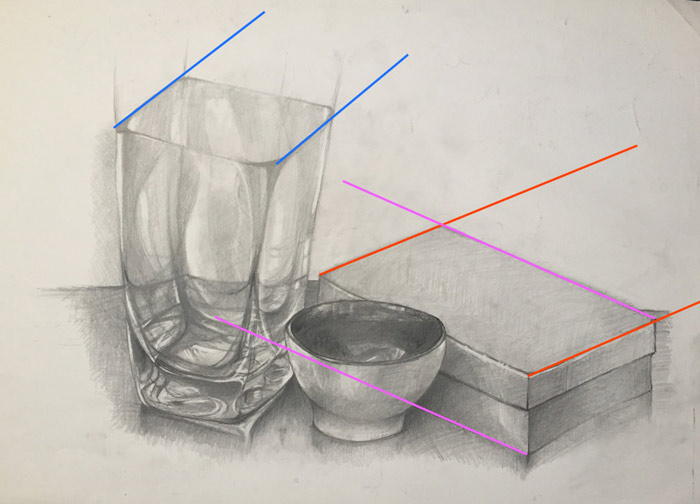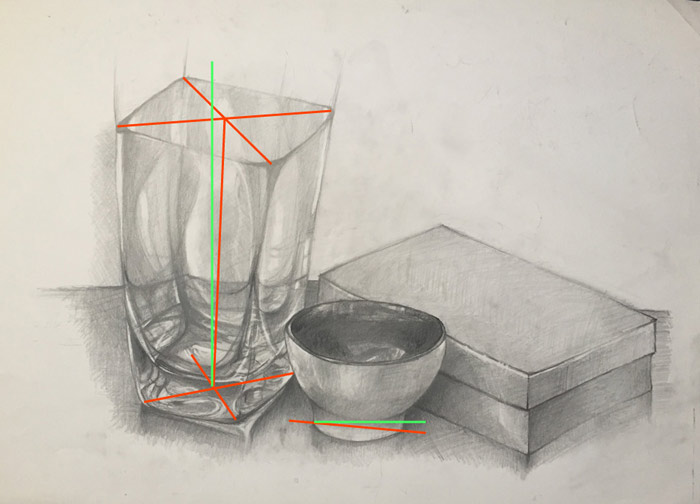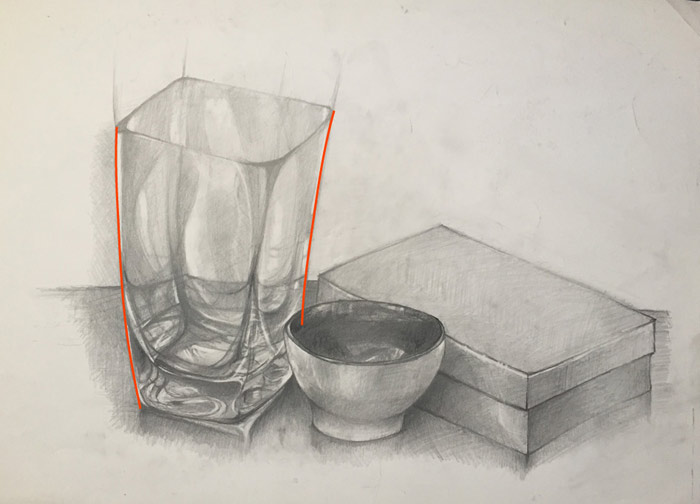Artwork from Geri, Drawing Academy student
Hi Drawing Academy tutors,
I’ve just registered and look forward to my journey on this art course.
Just to let you know I am a totally self-taught artist and have had no formal art training at all. As a child and young adult I found it quite easy to draw from my imagination but as I got older I started drawing from photos and now I’m even finding it quite difficult just to do that. I enjoy it but it takes me ages to create my artworks.
I’m just scared that I may not be able to break out of old bad habits like copying from photos.
Here’s one still-life I’ve done from life.

Many thanks
Geri
Hi Geri,
Many thanks for your drawing.
I like it a lot. Great work! You have a good eye for detail and strong tonal rendering skills. Your artwork resembles actual still life objects and is well-balanced and pleasing to look at.
At the same time, there is a big gap in your constructive drawing skills.
Every item in the drawing, including the table, has constructive mistakes. Those mistakes will be easy to avoid if you know and use very simple principles of constructive drawing.
Please don’t get me wrong; this is not your fault. As a self-taught artist, you have achieved great results. By the way, not many contemporary art college students graduate with the knowledge I’ve mentioned.
I will give you just a few examples of what can be improved in your drawing.
1. Linear perspective
None of the items have a believable perspective. The lines of the box (red and purple) would never meet in two vanishing points on the horizon line. Neither would the lines of the vase (blue).
The bowl has a reverse perspective because its top oval is fuller than the bottom one.

2. Drawing objects as if they were transparent
This rule is very easy to follow. Should you draw see-through objects, you would avoid many elementary mistakes.
For example, in your drawing, the table is broken. You can easily do it correctly by drawing one continuous line of the table edge through the box and the vase as if you could see through those objects.

The bowl and the box are intersecting. This happened because you did not draw a line of the box (marked in red) behind the bowl. You can see that the width of the bowl is represented as a cylinder (green and yellow lines) and the bottom plane of this cylinder (yellow oval) crosses the line of the box (red), which means the bowl intersects the box.

3. Symmetry
Needless to say, symmetrical objects in life should be symmetrical in a drawing. The way to ensure this is by drawing virtual axes of symmetry.
In your drawing, the vase is tilted, as is the bowl. You can see that the vertical axis of the vase’s symmetry (red) is not completely vertical (green). Even the base of the bowl is tilted.

The symmetry of the vase is also questionable with concave and convex sides.

4. Ovals
A classic beginner’s mistake is mishandling ovals. Ovals are circles in perspective. Circles do not have sharp corners; neither do ovals.
In your drawing, the bowl’s bottom plane has pointing edges. This will be easy to avoid if you know the rule and draw this oval fully, including its invisible half.

As you can see, the rules of constructive drawing are very simple, but you must know them and have the habit of using them.
Regarding tonal rendering, I very much like how you confidently depicted tonal values, but your pencil rendering technique can be improved. You apply strokes without lifting the pencil off the paper at the end of every mark, which doesn’t look great. Also, using 90-degree cross hatching seldom looks good when one is drawing objects other than cloth.
I hope this critique gives you enough to make your next still-life drawing better.
All these drawing principles are described in the Drawing Academy course in depth. Just watch video lessons one by one and apply what you have learned when drawing from life.
To your creative success,
Vladimir London
Drawing Academy tutor





Stunning critique which always makes me anxious in presenting my material for review. At first the drawing looked nice to me, then the critique came.
It is impossible to disagree with the critique…
This course is certainly mind bending.